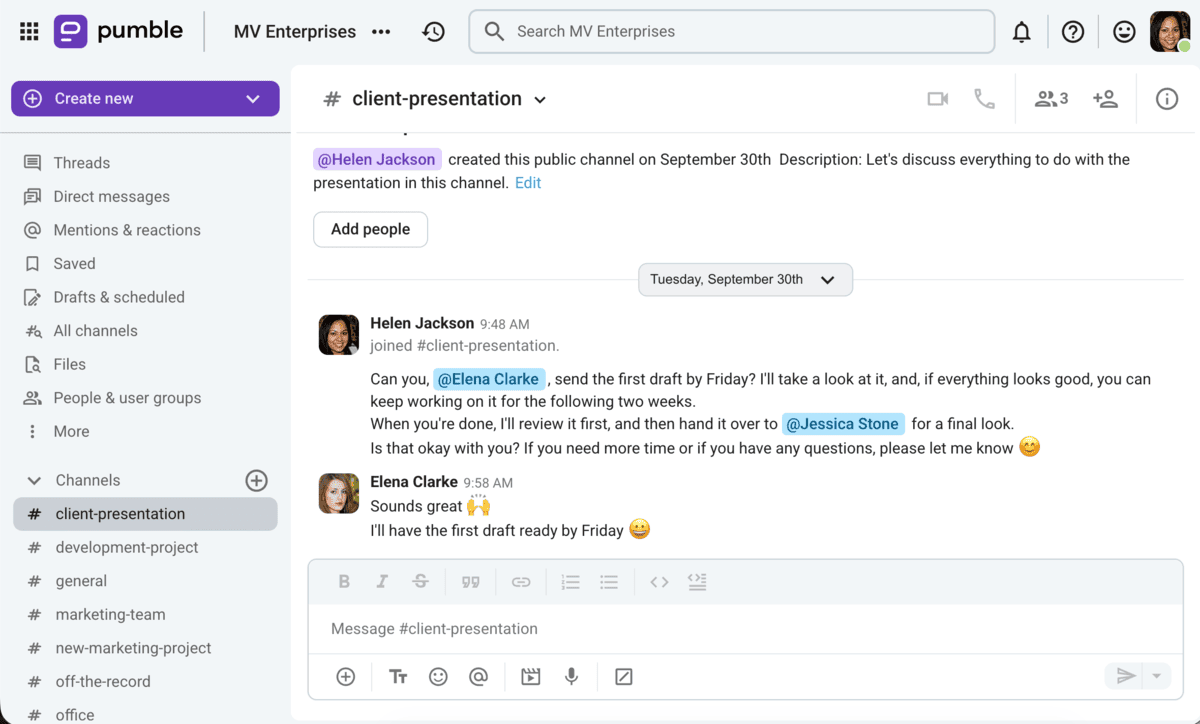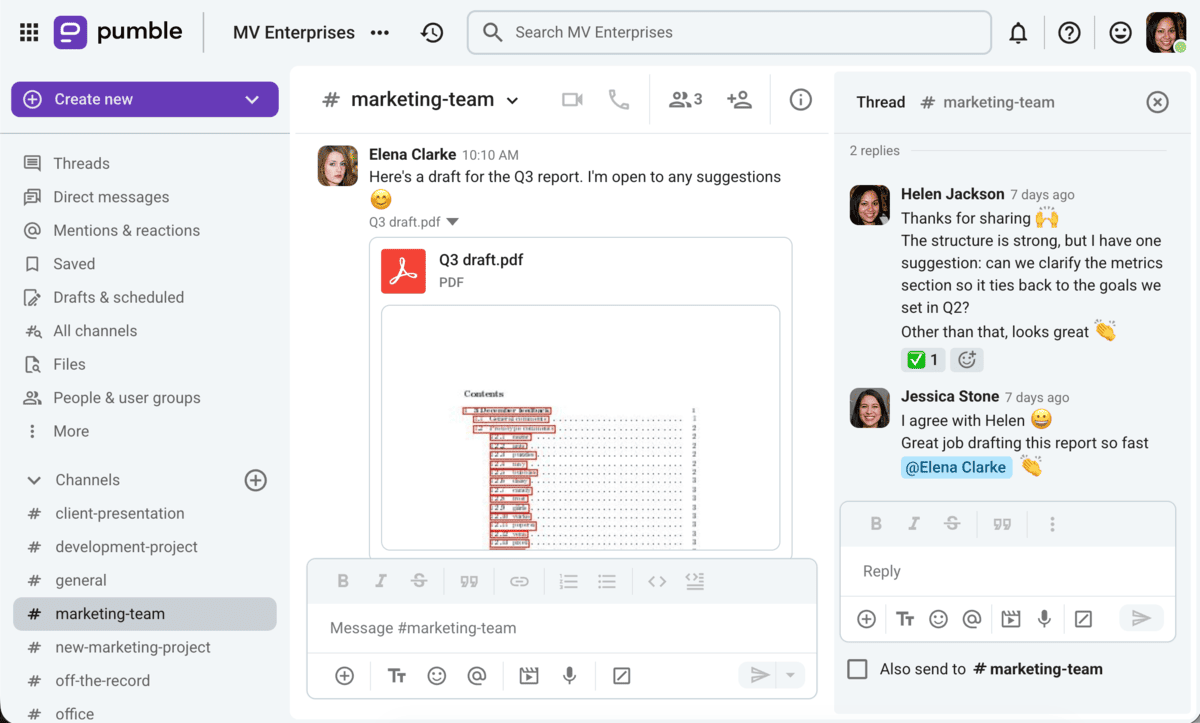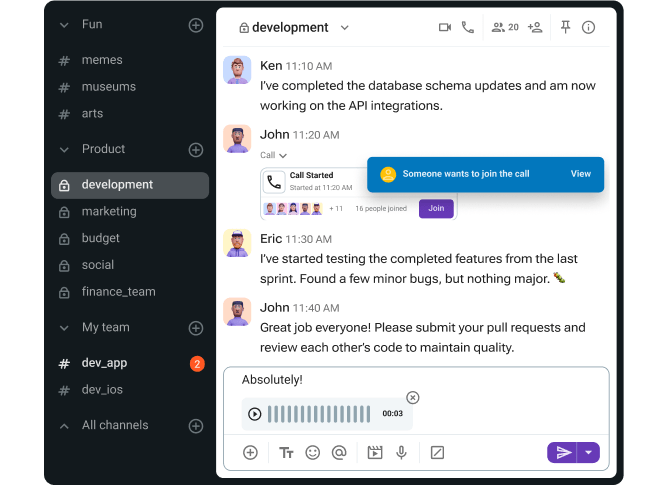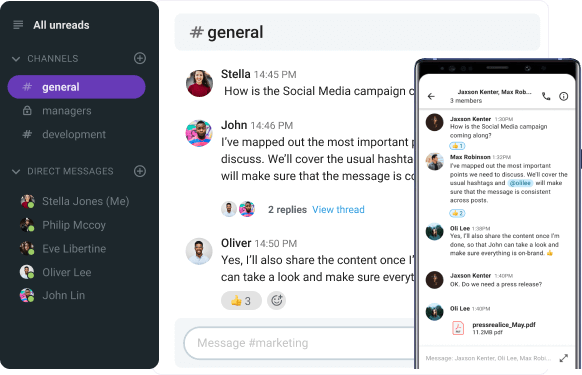“Let’s circle back and leverage some low-hanging fruit so we can move the needle.”
Sounds familiar? If your eyes just glazed over reading that, you’re not alone. Corporate jargon like this has become the background noise of modern workspaces.
What was once meant to sound professional often ends up confusing, empty, or downright irritating.
In the workplace, especially if you’re remote or hybrid, your words do more than just relay information. The vocabulary you choose can impact morale, signal your professionalism, and set the tone for collaboration.
A poorly worded message can easily come off as dismissive, negative, or even hostile, even if you didn’t mean it that way. On the flip side, a thoughtfully chosen phrase can build trust, encourage open communication, and keep projects moving forward smoothly.
That’s why mastering business communication words and phrases is no longer optional — it’s the foundation of effective workplace communication.
This guide is your practical playbook with real examples of what to say and what not to say and clear side-by-side comparisons.
You’ll also see how a tool like Pumble creates the perfect environment to put this professional vocabulary into practice.
Let’s start.

Table of Contents
Words and phrases for giving clear and constructive feedback
Feedback is one of the most high-stakes areas of communication.
Done poorly, it sounds like criticism. Done well, it inspires growth and strengthens teams.
The key to successful feedback is positive communication and focusing on clarity, tone, and active listening.
Without the right words, feedback can easily sound accusatory.
For example, saying: “You messed this up!” might make the other person defensive. However, if you say “Here’s how we can improve this together.”, it keeps the conversation open and focused on results.
Therefore, constructive feedback is all about:
- Being specific about the issue,
- Acknowledging the effort,
- Using positive communication, and
- Focusing on solutions.
On the left side of the table below, you have some common phrases used to give feedback that can feel negative and yield unwanted results. On the right side, you’ll find professional communication phrases that allow for a different way of giving feedback that can be more beneficial.
| Avoid: | Use: |
|---|---|
| You always miss deadlines. | I’ve noticed a few deadlines have slipped. Can we talk about what’s getting in the way? |
| This work isn’t good enough. | This is a solid start. Let’s refine X and Y so it meets the standard. |
| You need to try harder. | I think you can focus more on X to get better results. |
| Why can’t you get this right? | I see that this is challenging. Let’s walk through it together. |
| This is wrong. | This part doesn’t quite work. Let’s look at how to improve it. |
| You didn’t follow instructions. | I see some instructions weren’t clear. Let me explain better. |
| You’re not improving. | I’ve noticed some recurring issues. We’ll set up a plan for growth. |
| That was a mistake. | Next time, let’s try a different approach. |
| We’ve already talked about this. | We can revisit what we discussed to clarify next steps. |
| You failed on this task. | This task didn’t go as planned. What can we do differently next time to make sure it doesn’t happen again? |
| You never listen. | I want to make sure we’re on the same page. Can we go over this again? |
| You don’t understand. | I think the instructions may have been unclear, let me clarify. |
| This isn’t working. | This approach isn’t delivering the right results, let’s try another way. |
| You’re not meeting expectations. | Here are the expectations. Let’s see how we can close the gap. |
| You’re not doing it right. | This doesn’t align with our goal, let’s rework it together. |
People are more likely to engage with feedback when they feel respected and heard.
If your words show professionalism, empathy, and a focus on solutions, you’ll help the other person see the feedback as a tool for growth, not punishment.
Imagine you’re a manager reviewing a report. Instead of saying to your team member: “This report is sloppy, you need to redo it.”, you could say: “This report has some good insights. To strengthen it, could you expand on X section and double-check the information on page Y?”
One approach discourages, the other guides improvement.
💡 Pumble Pro Tip
Asking your manager for feedback can be daunting, but it’s an important skill you should be working on. To learn more about how to ask for feedback and why it’s important to do so, check out our blog post:
Words and phrases for making requests and delegating tasks with clarity
Unclear delegation creates frustration and bottlenecks.
Oftentimes, workplace miscommunication happens because requests are vague or incomplete.
Using effective communication phrases ensures that tasks are understood and expectations are set without micromanaging every step of the process.
When you make requests and delegate tasks, think about 3 main points:
- What needs to be done,
- What the deadline is, and
- Why it’s important.
Too often, people skip one of these, leading to confusion or misunderstandings.
Communicate your requests effectively on Pumble
Also, when you’re making requests or delegating, make sure to use an appropriate tone and positive communication — this makes people feel trusted and needed, rather than bossed around.
In the table below, we’ve compiled some examples of professional communication phrases for making requests.
| Avoid: | Use: |
|---|---|
| Can you handle this? | Can you complete this by [date]? Here’s the context and priority. |
| I need this ASAP. | Can you finish this by [specific deadline]? Let me know if it works for you. |
| Just do it however you think is right. | Please follow the rough outline, but feel free to improve upon it however you see fit. I trust your judgment. |
| I’ll explain the details later, just start working. | Here are the key details to get started. I’ll share additional information as soon as possible. |
| Don’t mess this up. | This project is important, I trust your skills to deliver it well. |
| This is your problem now. | I’d like you to take the lead on this now. |
| Get it done by EOD. | Please take care of this task and update me on your progress by [time] today. It would be ideal to have it done by the end of the day. |
| I don’t care how you do it. | We’ve discussed the needed outcome. I trust your skills and judgment on how to get there. |
| Just figure it out. | Here are some resources to help you. Let me know if you run into any problems. |
| You should already know this. | Here’s a quick rundown so you’re clear on what’s needed. |
| I need this now. | Could you prioritize this now and complete it by [specific time]? |
| Do it my way. | You can follow my approach for consistency, but if you see any room for improvement, let me know. |
| Why isn’t this done yet? | Can you update me on your progress and any blockers you’re facing? |
| This shouldn’t take you that long. | This is a smaller task, but still take the time you need to do it well. |
| Don’t ask questions, just do it. | If anything is unclear, let me know so we can avoid rework. |
Knowing how to make requests is a necessary skill to have, especially if you’re a leader.
Polite requests and clear delegation empower people because they know exactly what’s expected of them and why their work matters.
Imagine how you would feel if someone handed you a task and just said: “Get this done.” You don’t have any details, you’re unclear of what the deadline is, and you feel bossed around because of the tone.
However, if the same task was delegated to you by saying: “Could you take on this task and finish it by tomorrow at noon? I’ll send you additional information shortly and you can pause your current tasks until you finish this. Feel free to ask any questions.”
This tone is more helpful because it sets clear expectations and invites dialogue, but does this in a way that doesn’t feel overbearing.
💡 Pumble Pro Tip
If you find that making requests feels uncomfortable, we have a couple of resources that can help you with specific situations you’ll likely encounter at work. Check them out by following the links below:
Words and phrases for disagreeing respectfully and pushing back productively
Healthy disagreement drives innovation, but the wrong tone and choice of words can make it feel personal.
To keep disagreements professional, you need to choose words and phrases that:
- Show active listening,
- Acknowledge the other perspective, and
- Reframe the conversation towards a solution.
Disagreement isn’t about winning — it’s about finding the right solution to a problem.
Phrases like: “That’s wrong.” shut conversations down. Phrases like: “That’s an interesting point, here’s another angle.” keep the dialogue going.
The goal of respectful disagreements is to balance respect with honesty. Here are some examples of how you can do that.
| Avoid: | Use: |
|---|---|
| That’s wrong. | I see where you’re coming from, but here’s another perspective to consider. |
| We tried that before, it won’t work. | That’s similar to what we tested earlier. What’s different now that could make it work? |
| I disagree. | I have a different take I could share. |
| We can’t do that. | I see some potential problems with that, such as [give an example]. Could we try X instead? |
| That doesn’t make any sense. | I’m not sure I follow. Could you walk me through your thinking? |
| That’s impossible. | That could be tough given our resources. How else can we tackle this? |
| That’s a waste of time. | I’m concerned about the ROI. What benefit do you see in this approach? |
| We’ve never done it that way. | That would be new for us, what advantages do you think it could bring? |
| That’s a bad idea. | There may be some downsides to that, for example [give an example]. Have you considered X? |
| That’s unrealistic. | That might be challenging given [constraints]. How could we adjust to make it possible? |
| You’re misunderstanding. | I think we may be looking at it differently. I’ll share my point of view. |
| We don’t have time for that. | The timeline is tight. How can we simplify this to make it in time? |
| I don’t like this idea, let’s drop it. | This isn’t the right fit for our objectives right now. We can revisit it at a later date. |
| I know better than you. | Thank you for the input. Based on my experience, here’s another approach I’d recommend. |
| Don’t question my skills/expertise/knowledge. | This falls within my expertise, so I feel comfortable taking the lead. |
Disagreement is best resolved when it’s framed as collaboration, not conflict.
By acknowledging the other person’s ideas and using positive language throughout, you show professionalism and a commitment to constructive solutions, even when you’re pushing back.
For example, saying: “That won’t work, it’s too expensive.” shuts down ideas and sounds harsh and hypercritical.
Instead, you could try something like: “That’s a creative idea. I’m concerned about the budget, though. What if we scaled it back for now and tested the concept before going all-in?”
This type of response keeps the conversation open and productive, without making the other person feel disrespected or disregarded.
💡 Pumble Pro Tip
Disagreements can sometimes turn into conflicts. To avoid escalating the situation, learn more about conflict resolution and what to say during disagreements to steer them in a constructive direction:
Words and phrases for taking ownership and apologizing effectively
Accountability earns respect — excuses erode credibility.
People respect leaders and colleagues who can say: “I made a mistake, here’s how I’ll fix it.”
The most professional communication phrases for apologizing combine ownership with action.
Apologies are not about blame-shifting or softening responsibility. They’re about:
- Acknowledging mistakes and their impact,
- Accepting responsibility, and
- Focusing on solutions.
Saying: “Sorry, but…” is one of the quickest ways to undermine your apology — it shows you’re making excuses.
For effective communication phrases for apologizing and taking accountability, take a look at the table below.
| Avoid: | Use: |
|---|---|
| It wasn’t my fault. | I should have caught that. I’ll make sure to prevent it next time. |
| Things just got busy. | I didn’t prioritize this well. I’ll adjust my process going forward. |
| That’s on someone else. | I was part of this process, so I share responsibility. Here’s how I can help fix it. |
| Sorry, but… | I take responsibility for this mistake. Thank you for pointing it out. |
| I can’t do anything about it now. | Here’s how I can help to move us forward. |
| It’s not that big of a deal. | I realize this caused issues. Thank you for flagging it, I’ll fix it ASAP. |
| I didn’t think it mattered. | I see now this was important. Next time, I’ll make it a priority. |
| I’m sorry you feel that way. | I understand my actions affected you. I apologize and I’ll make sure it doesn’t happen again. |
| That’s not my responsibility. | I could have contributed more. I’ll be more involved next time. |
| I’ll try to do better. | Here are specific steps I’ll take to avoid this happening again. |
| That’s not what I meant. | I see how that came across differently, let me clarify. |
| Nobody told me. | I missed that communication. Next time, I’ll make sure to confirm. |
| I guess I messed up. | I made an error. Thank you for letting me know, I’ll fix it right away. |
| There was nothing I could do. | I couldn’t change the situation, but here’s what I’ll do differently in the future. |
| It’s not my problem. | I could have been more proactive. I will help you resolve it. |
When you take responsibility for your mistakes, you strengthen trust and show professionalism.
For example, instead of saying: “I’m sorry, but I was swamped with work and couldn’t get this done.”, you could say: “I didn’t manage my priorities well and the deadline slipped. I apologize for the delay. I’ll adjust my process and deliver the task by tomorrow morning.”
The first phrase weakens credibility, and the second one builds it.
Apologize privately and effectively with Pumble
Words and phrases for expressing appreciation and recognition effectively
Recognition is one of the most powerful tools in workplace communication, yet it’s often underused or delivered in vague, unhelpful ways.
A simple “Good job” may feel nice in the moment, but it doesn’t reinforce the specific behaviour you want to see repeated, nor does it convey true appreciation.
The right phrases show that you:
- Notice the effort,
- Value the contribution, and
- Understand the impact on the bigger picture.
When recognition is clear and specific, you build a culture of appreciation rather than one of empty words. The more precise you are about what you’re recognizing, the more meaningful your words become.
Provide meaningful recognition with Pumble
For ideas on how to give more genuine appreciation with specific examples, take a look at the table of effective communication phrases below.
| Avoid: | Use: |
|---|---|
| Good job! | Great work on simplifying the data, it made the client presentation much clearer. |
| Thanks! | Thank you for staying late yesterday to ensure the report was ready. |
| You’re awesome! | Your quick thinking kept the project moving forward smoothly. It’s much appreciated! |
| Nice work! | The way you structured the proposal really highlighted our strengths. |
| Well done! | Well done on catching that error before it was too late! |
| Appreciate it! | I appreciate how you coordinated across teams to get everyone ready. |
| Thanks for the help! | Thanks for stepping in at the last minute, your support made making the deadline possible. |
| Solid work! | The creative angle you suggested added real value to the campaign, great job! |
| That was fast! | You delivered ahead of schedule without compromising quality — impressive work! |
| Good thinking! | Your idea to test a smaller project first minimized risk, smart call! |
Of course, there are times when the shorter phrases — like “Thanks!” or “Nice work!” — are perfectly acceptable.
In fast-moving conversations or casual moments, conciseness feels natural and helps keep communication light.
However, specificity is far more powerful if you want to:
- Reinforce positive behaviour,
- Build trust, and
- Motivate and engage your team.
Clear recognition not only makes people feel valued, it also shows the whole team exactly what good work looks like.
💡 Pumble Pro Tip
Saying “Thank you” can be an effective way of expressing your appreciation, but only if done correctly. To learn more about how to professionally and effectively say “Thank you”, read our blog post:
Business jargon to avoid: 20 buzzwords to stop using today
Business communication has a bad habit of getting clogged with buzzwords. These words and phrases often start as clever and useful shorthand, but quickly spiral into overuse.
When people hear words and phrases like synergy or low-hanging fruit, they may roll their eyes instead of leaning into the conversation.
After a while, buzzwords and overused business jargon doesn’t impress or entertain anyone — it just:
- Creates noise,
- Annoys team members, and
- Makes leaders sound less genuine.
The truth is, your colleagues and clients don’t want to decode buzzwords. They want clarity, conciseness, and professionalism.
The fastest way to achieve that? Swap out business jargon for plain language that actually means something.
Doing so will make your communication:
- Clearer,
- More accessible, and
- Far more persuasive.
Make your communication clear with Pumble
Here’s a list of the most common and most annoying corporate buzzwords and business jargon to avoid (and what to use instead):
| Avoid: | Use: |
|---|---|
| Synergy | Collaboration, teamwork |
| Circle back | Follow up, talk about it later |
| Low-hanging fruit | Simple task |
| Boil the ocean | Attempt an unrealistic task |
| Bandwidth | Capacity, time/energy to handle something |
| Blue-sky thinking | Creative thinking |
| Touch base | Connect, check in |
| Herding cats | Hard to manage |
| Pick someone’s brain | Ask for advice, consult, learn from someone |
| Pivot | Adjust strategy |
| Leverage | Use, take advantage of |
| Take it offline | Discuss in private, discuss another time |
| Drill down | Look deeper, analyze in detail |
| Move the needle | Make progress, create impact |
| Stick a pin in it | Set aside, pause for now |
| No-brainer | Easy decision, obvious choice |
| Think outside the box | Be creative, explore different ideas |
| Go the extra mile | Go above expectations |
| Get our ducks in a row | Get organized, line things up |
| Ping someone | Message, contact, reach out |
The takeaway here isn’t that you should never use colorful language. It’s that your audience values clarity over clichés.
Instead of sprinkling in tired catchphrases, say exactly what you mean.
So, rather than saying “We don’t have the bandwidth,” say “Our team is not able to work on any new tasks right now.”
Instead of “circling back,” say “Let’s meet again tomorrow to finalize this.”
Clear words resonate more strongly, save time, and ensure your message is clear.
So, next time you’re tempted to reach for one of these buzzwords, pause and ask yourself if there’s a clearer way to say what you mean. Your colleagues, and your credibility, will thank you.
Complex words and phrases to avoid and their simpler alternatives
In business communication, there’s a common temptation to reach for long, complex words even when short, clear ones will do.
You might think this makes you sound smarter or more professional — but in reality, it often creates the opposite effect.
Overly complicated words and phrases can:
- Confuse,
- Slow down communication, and even
- Come across as pretentious.
Clear, simple words are not only easier to understand but also more effective at building trust and ensuring your message lands.
The goal isn’t to impress your team members — it’s to connect and communicate effectively.
In the table below, we’ve compiled some unnecessarily complex words and phrases and given you their simple, yet effective alternatives.
| Avoid: | Use: |
|---|---|
| Utilize | Use |
| Commence | Start |
| Terminate | End |
| Endeavor | Try |
| Facilitate | Help |
| Optimal | Best |
| Mitigate | Reduce |
| Procure | Get |
| Deem | Believe |
| Encounter | Meet |
| Equitable | Fair |
| Articulate | Explain |
| Implement | Apply |
| Magnitude | Size |
| Indicate | Show |
| Ascertain | Find out |
| Rectify | Fix |
| Notify | Tell |
| In the event that | If |
| Concerning the matter of | About |
Naturally, complex words aren’t always bad. They have their place in technical writing, formal documents, contracts, etc.
But in everyday communication — emails, chats, and meetings — simplicity wins.
Using straightforward vocabulary for business communication will:
- Save time,
- Remove communication barriers, and
- Ensure everyone is on the same page.
Clarity signals professionalism far more than complexity ever will.
Effortlessly chat with team members in Pumble
The right words in the right place: How Pumble fosters better communication
Words matter, but so does the environment in which they are shared.
Even the most thoughtful and professional business communication words and phrases lose power if they’re scattered across inboxes, buried in random chats, or stripped of context.
For effective business communication, you need a space that:
- Provides clarity,
- Encourages dialogue, and
- Preserves the communication habits your team works hard to build.
That’s where Pumble, a business communication platform, comes in.
Pumble is designed to simplify and advance your business communication with powerful features that enable clarity and professionalism, such as:
- Channels,
- Threads, and
- Unlimited message history.
Pumble gives your team the right environment to communicate effectively and professionally, by providing context, organization, and a permanent record of communication.
Channels for clear and organized communication
Imagine giving feedback or assigning a task without needing to re-explain the project from scratch. That’s what Pumble channels help you with.
Each channel is dedicated to a specific team, project, or topic, which means that context is already built into the conversation.
Instead of wasting time on background details, you can focus on what really matters.
For example, you can create a channel dedicated to one project, where team members can:
- Discuss everything to do with that specific project,
- Share files,
- Give feedback, and
- Start voice or video calls with relevant team members.

Compare that to dropping the same request in a random group chat — it would almost certainly require more clarification. Anchoring your communication in the right channels makes your words clearer and easier to act on.
Experience organized communication — try Pumble
Threads for cutting back on clutter
One of the biggest challenges in workplace communication is noise.
Channels can move fast and valuable information can get buried under unrelated messages. That’s where threads become useful.
Threads let you respond directly to a message without derailing the main channel. For example, if a team member shares a draft report in a channel, you can give feedback in a dedicated thread, keeping all comments tied to the original message.

By containing the exchange in a thread, the conversation stays effective, productive and easy to track — no buried comments and no lost feedback.
Eliminate cluttered inboxes with Pumble
Permanent record for building a positive culture with no limits
Professional communication isn’t just about singular interactions — it’s about creating a culture.
Over time, the way your team speaks to one another becomes the identity of your workplace.
Pumble helps preserve and strengthen that culture by making every conversation part of a searchable, permanent knowledge base.
With unlimited message history, you have a transparent, searchable history that reinforces accountability and trust.
Over time, these interactions set the tone for how your team communicates and allow your organization to develop a healthy team culture and communication style.
Build healthy team communication habits with Pumble
Maintain effective business communication with Pumble
Clear, respectful, and professional communication works best in an environment built for it — and that’s exactly what Pumble provides.
With channels for context, threads for focus, and a hub to build your team culture in, Pumble helps teams elevate their business communication.
Ready to make your workplace communication more effective?








